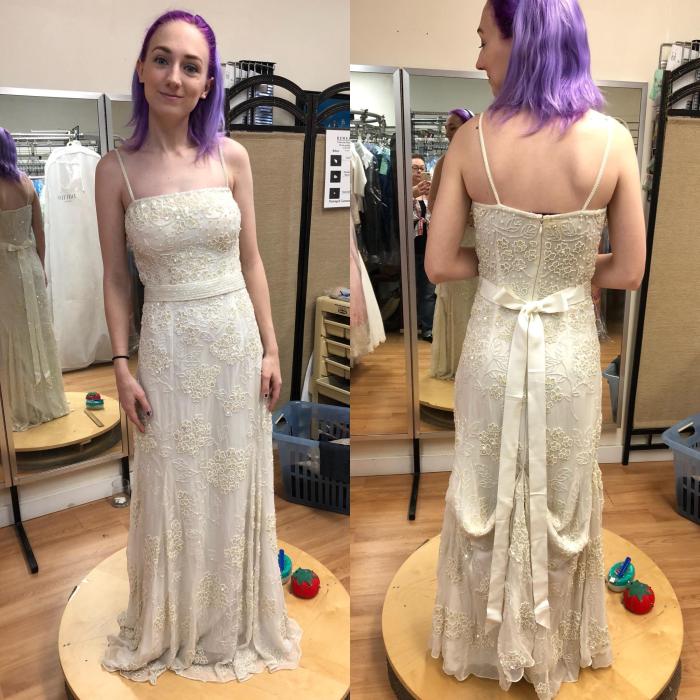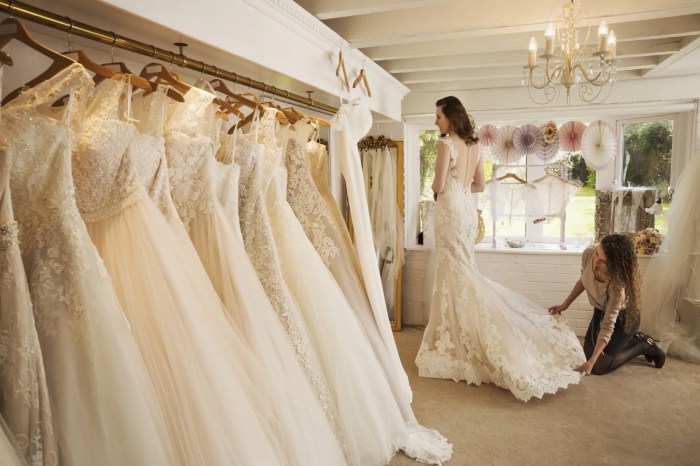Understanding the Target Audience for Wedding Dress Sale Events

Source: redd.it
Identifying the ideal customer for a wedding dress sale event is crucial for effective marketing and sales. This involves understanding their demographics, motivations, and purchasing behaviors.
Typical Demographics of Brides Shopping During Sale Events, Wedding dress sale event

Source: opportunitybridal.com
Brides shopping during sale events often fall within specific demographic ranges. They may be budget-conscious millennials or Gen Z individuals prioritizing value for money. Some might be planning smaller, more intimate weddings, making a sale event an attractive option to offset other wedding costs. Others could be brides who are flexible with their wedding date and willing to take advantage of last-minute deals.
Our wedding dress sale event offers incredible discounts on a wide variety of styles. If you’re struggling to find the perfect gown, perhaps checking out this helpful resource for inspiration might help: wedding dress option crossword clue. This could spark some ideas, leading you to the dream dress at a price you’ll love during our sale.
Don’t miss out on these amazing deals!
Key Motivations Driving Brides to Seek Sale Deals
Several factors drive brides to seek sale deals on wedding dresses. Budget constraints are a primary driver, with many brides looking to save money on their attire without compromising style. Time sensitivity, such as a shorter engagement period or a last-minute wedding date change, can also influence their decision to purchase during a sale. The desire for a specific designer or style at a reduced price is another compelling factor.
Buyer Persona: The Ideal Customer
Our ideal customer for a wedding dress sale event is “Sarah,” a 28-year-old millennial bride-to-be. Sarah is planning a moderately sized wedding with a budget of $20,000. She is tech-savvy, follows wedding blogs and influencers on social media, and is looking for a stylish, yet affordable wedding dress. Sarah values quality but is also pragmatic about finding a good deal.
She is likely to be influenced by online reviews and testimonials.
Marketing Message Tailored to the Buyer Persona
A targeted marketing message for Sarah might emphasize the value proposition of the sale event. For example: “Find your dream wedding dress without breaking the bank! Our exclusive sale event offers stunning designer gowns at unbelievable prices. Shop now and say ‘yes’ to the dress – and your budget!”
Analyzing Competitor Strategies for Wedding Dress Sale Events
Analyzing competitor strategies is essential to gain a competitive advantage. This involves comparing pricing, unique selling propositions, promotional channels, and the success of past campaigns.
Competitor Pricing Strategies
Three competing businesses, “Bridal Bliss,” “Elegant Gowns,” and “The Wedding Shoppe,” each employ different pricing strategies during their sale events. Bridal Bliss offers a percentage discount on all dresses. Elegant Gowns features tiered discounts based on the original price of the dress. The Wedding Shoppe offers a combination of percentage discounts and specific price reductions on select styles.
Unique Selling Propositions (USPs)
Each competitor utilizes unique selling propositions. Bridal Bliss emphasizes its wide selection of designer brands. Elegant Gowns highlights its personalized styling consultations. The Wedding Shoppe focuses on its convenient online shopping experience and in-store pickup option.
Effectiveness of Promotional Channels
Competitors use various channels, including social media marketing, email campaigns, and influencer collaborations. Bridal Bliss effectively leverages Instagram for visually appealing content. Elegant Gowns excels in email marketing with targeted promotions. The Wedding Shoppe successfully uses local media partnerships to reach a wider audience.
Examples of Successful and Unsuccessful Sale Event Campaigns
Analyzing past campaigns reveals valuable insights. The following table showcases examples:
| Company Name | Promotion Type | Success Metrics | Key Learnings |
|---|---|---|---|
| Bridal Bliss | 20% off all dresses | Increased website traffic by 50%, 15% increase in sales | Strong discounts drive traffic, but conversion rates need improvement. |
| Elegant Gowns | Tiered discounts, influencer collaboration | High conversion rate (10%), positive social media engagement | Influencer marketing generates high-quality leads and builds brand trust. |
| The Wedding Shoppe | Flash sale, limited-time offer | High initial sales but low customer retention | Limited-time offers drive urgency, but post-sale engagement needs improvement. |
Designing Effective Marketing Materials for a Wedding Dress Sale Event
Creating compelling marketing materials is key to attracting potential customers. This includes ad copy, email campaigns, and visually engaging assets.
Compelling Social Media Ad Copy
Examples of social media ad copy: “Dream dress, dream price! Our wedding dress sale event is here! Shop now and find your perfect gown at a fraction of the cost. #WeddingDressSale #BridalDeals” or “Say ‘Yes!’ to the dress AND your budget! Our exclusive sale event offers incredible savings on stunning bridal gowns. Limited time only! #WeddingGowns #SaleEvent”
Email Marketing Campaign
An email campaign could announce the sale with a subject line like “Your Dream Dress Awaits: Exclusive Wedding Dress Sale!” The body would include details of the sale, dates, discounts, a call to action (e.g., “Shop Now”), and visually appealing images of dresses.
Engaging Visuals
Visuals should evoke emotions. For online and print materials, use a palette of soft, romantic colors like blush pink, ivory, and champagne gold. Images should showcase happy, diverse brides in elegant gowns. The styling should be sophisticated and aspirational, emphasizing the beauty and quality of the dresses.
Font Selection and Psychological Impact
Fonts like elegant serif fonts (e.g., Garamond, Times New Roman) can create a sense of sophistication and tradition, while modern sans-serif fonts (e.g., Helvetica, Arial) project a clean, contemporary feel. The chosen font should align with the overall brand aesthetic and target audience.
Planning the Logistics of a Successful Wedding Dress Sale Event
Meticulous planning ensures a smooth and successful sale event. This involves creating a detailed timeline, managing inventory, handling potential issues, and tracking sales data.
Detailed Timeline
A timeline would include phases such as pre-event planning (marketing, inventory management, staff training), the sale event itself (customer service, sales tracking), and post-event activities (data analysis, follow-up). Specific dates and deadlines should be assigned to each task.
Inventory and Customer Flow Management
Efficient inventory management involves organizing dresses by size and style for easy access. A system for managing customer flow, such as appointment scheduling or a queuing system, ensures a positive shopping experience. Clear signage and staff guidance are essential.
Handling Potential Issues
A plan for handling returns, sizing problems, and high customer volume is crucial. Having a designated area for returns, readily available alterations services, and additional staff during peak hours helps mitigate these issues. Clear return policies should be communicated upfront.
Sales Data and Customer Feedback Tracking
Tracking sales data (number of dresses sold, revenue generated, average order value) and customer feedback (surveys, reviews) provides valuable insights for future events. A dedicated system, either manual or digital, should be used for data collection and analysis.
Promoting the Wedding Dress Sale Event Across Different Channels
A multi-channel approach maximizes reach and engagement. This involves leveraging social media, email marketing, paid advertising, and influencer collaborations.
Social Media Strategy
A social media strategy should include creating engaging content (photos, videos, stories) across platforms like Instagram, Facebook, and Pinterest. Targeted advertising campaigns can reach specific demographics. Running contests and giveaways can increase engagement.
Email Marketing Plan
Email marketing involves sending targeted emails to subscribers announcing the sale, highlighting key offers, and including compelling visuals. Segmented email lists can ensure personalized messaging based on customer preferences.
Paid Advertising Options
Paid advertising options like Google Ads and social media ads allow for precise targeting of potential customers. research and ad copy optimization are essential for effective campaigns. Tracking metrics like click-through rates and conversions provides valuable data.
Collaborations with Wedding Bloggers or Influencers
Collaborating with wedding bloggers or influencers can generate publicity and reach a wider audience. Influencers can showcase dresses, share their experience, and drive traffic to the sale event. This requires careful selection of influencers whose audience aligns with the target market.
Post-Event Analysis and Optimization Strategies
Analyzing data and feedback after the event is crucial for continuous improvement. This involves collecting data, identifying areas for improvement, enhancing customer experience, and repurposing marketing materials.
Data Collection and Analysis
Data analysis involves reviewing sales figures, website traffic, social media engagement, and customer feedback. This data provides insights into the success of the sale event and identifies areas for improvement. Key performance indicators (KPIs) should be tracked and analyzed.
Areas for Improvement
Based on the data, areas for improvement could include adjusting pricing strategies, refining marketing messages, improving website usability, or enhancing customer service procedures. Specific actions should be identified to address these areas.
Enhancing Customer Experience
Enhancing customer experience involves addressing negative feedback, implementing improvements based on customer suggestions, and providing exceptional service throughout the shopping process. Personalized follow-up emails and loyalty programs can foster customer satisfaction.
Repurposing Marketing Materials

Source: co.uk
Repurposing marketing materials involves adapting existing content for future use. Social media posts can be repurposed for email newsletters, blog posts can be turned into social media snippets, and sale event photos can be used in future marketing campaigns. This saves time and resources.
Essential Questionnaire
What are common reasons for returns during a wedding dress sale?
Common reasons include sizing issues, change of wedding plans, or simply changing preferences after the initial purchase.
How can I manage high customer volume during the sale?
Implement an appointment system, hire additional staff, and clearly delineate waiting areas to maintain order and efficiency.
What types of data should I track during and after the sale event?
Track sales figures, customer demographics, feedback, website traffic, and social media engagement to assess overall success and identify areas for improvement.
How can I handle negative customer feedback effectively?
Respond promptly, empathetically address concerns, and offer solutions or compromises to resolve issues and maintain positive brand reputation.
